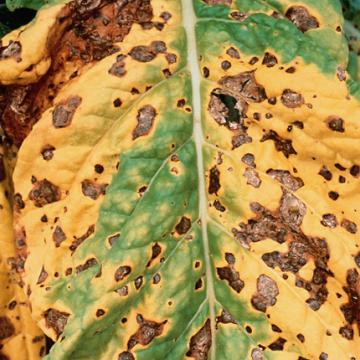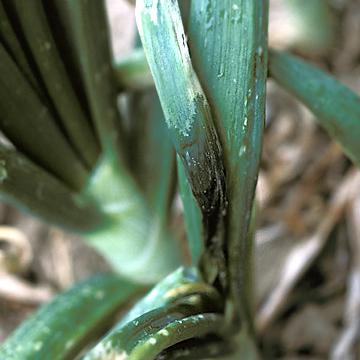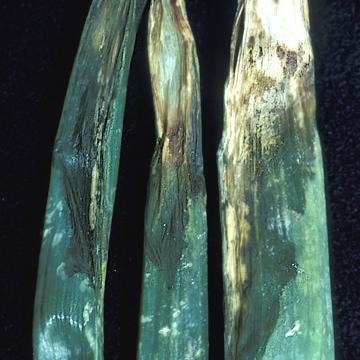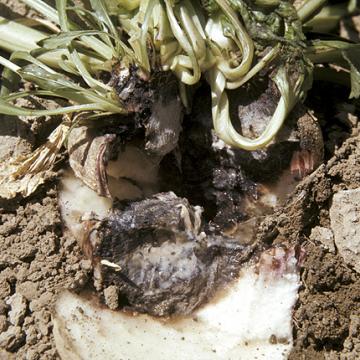DISEASE: Angular leaf spot
HOST: Tobacco
Leaf with light brown, angular spots. The difference between this disease and wildfire of tobacco is that wildfire is caused by a strain that produces tabtoxin. It causes conspicuous halos around lesions and large parts of a leaf may turn yellow .

Angular leaf spot | Tobacco
DISEASE: Angular leaf spot
HOST: Tobacco (Nicotiana tabacum)
PATHOGEN: Pseudomonas syringae pv. tabaci
SOURCE: H. Shew
DISEASE: Angular leaf spot
HOST: Tobacco
Yellowing of adjacent tissues occur as spots age (midseason). It causes conspicuous halos around lesions. Large parts of a leaf may turn yellow.

Angular leaf spot | Tobacco
DISEASE: Angular leaf spot
HOST: Tobacco (Nicotiana tabacum)
PATHOGEN: Pseudomonas syringae pv. tabaci
SOURCE: H. Shew
DISEASE: Angular leaf spot
HOST: Tobacco
Severely diseased leaf with extensive yellowing.
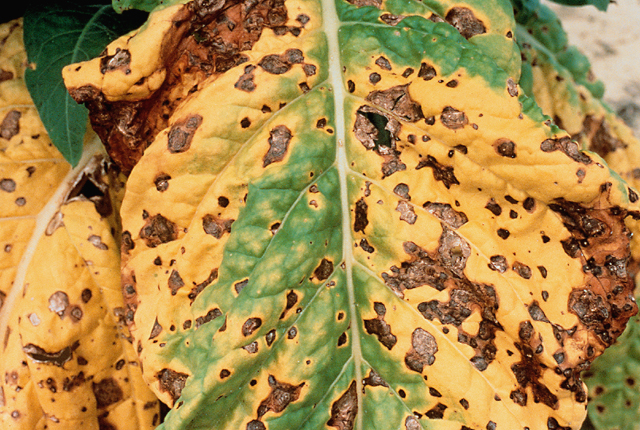
Angular leaf spot | Tobacco
DISEASE: Angular leaf spot
HOST: Tobacco (Nicotiana tabacum)
PATHOGEN: Pseudomonas syringae pv. tabaci
SOURCE: H. Shew
DISEASE: Bacterial flower stalk and leaf necrosis
HOST: Onion
Dark, rotted areas of stalk and leaves caused by systemic invasion of the pathogen.
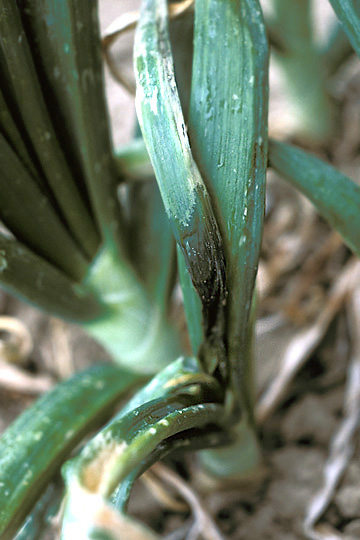
Bacterial flower stalk and leaf necrosis | Onion
DISEASE: Bacterial flower stalk and leaf necrosis
HOST: Onion (Allium cepa)
PATHOGEN: Pseudomonas marginalis pv. marginalis
SOURCE: S. Mohan
DISEASE: Bacterial flower stalk and leaf necrosis
HOST: Onion
Gray-brown rot of onion after inoculation. Disease starts as small, water-soaked lesions that later develop into slimy, gray-brown rot. The disease progresses downward from the stalk and may rot the entire bulb.
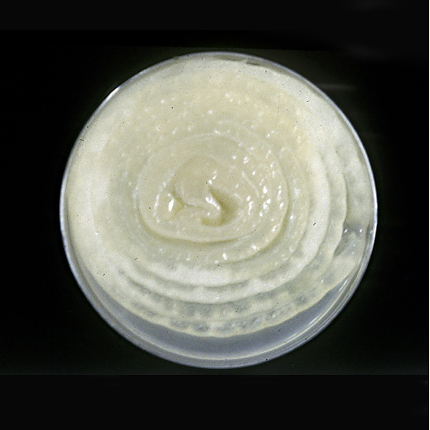
Bacterial flower stalk and leaf necrosis | Onion
DISEASE: Bacterial flower stalk and leaf necrosis
HOST: Onion (Allium cepa)
PATHOGEN: Pseudomonas marginalis pv. marginalis
SOURCE: R. Gitaitis
DISEASE: Bacterial flower stalk and leaf necrosis
HOST: Onion
Leaves with necrosis and rot. The common name for this disease is the same as those used for two other diseases. Also, another common name for this disease is bacterial soft rot.
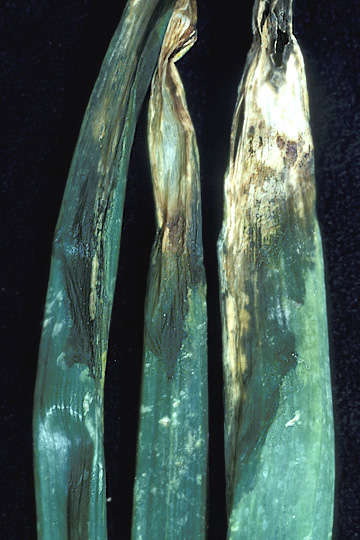
Bacterial flower stalk and leaf necrosis | Onion
DISEASE: Bacterial flower stalk and leaf necrosis
HOST: Onion (Allium cepa)
PATHOGEN: Pseudomonas marginalis pv. marginalis
SOURCE: S. Mohan
DISEASE: Bacterial soft rot
HOST: Cabbage
Rot of cabbage caused by Pseudomonas marginalis pv. marginalis. Rot caused by P. viridiflava has similar symptoms of water-soaking and blackening of cabbage heads. Both diseases occur mainly during the winter season.

Bacterial soft rot | Cabbage
DISEASE: Bacterial soft rot
HOST: Cabbage (Brassica oleracea var. capitata)
PATHOGEN: Pseudomonas marginalis pv. marginalis
SOURCE: M. Goto
DISEASE: Bacterial vascular necrosis and rot
HOST: Beet
Cross section of sugar beet with reddish color in vascular bundles and adjacent tissues.
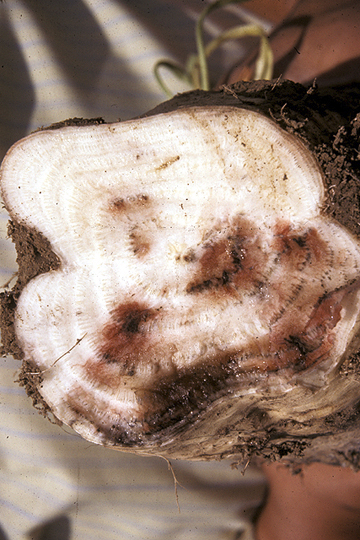
Bacterial vascular necrosis and rot | Beet
DISEASE: Bacterial vascular necrosis and rot
HOST: Beet (Beta vulgaris)
PATHOGEN: Pectobacterium betavasculorum
PATHOGEN SYNONYM: Erwinia carotovora subsp. betavasculorum
SOURCE: M. Schroth
DISEASE: Bacterial vascular necrosis and rot
HOST: Beet
Advanced stage of disease with extensive rot.

Bacterial vascular necrosis and rot | Beet
DISEASE: Bacterial vascular necrosis and rot
HOST: Beet (Beta vulgaris)
PATHOGEN: Pectobacterium betavasculorum
PATHOGEN SYNONYM: Erwinia carotovora subsp. betavasculorum
SOURCE: M. Schroth




